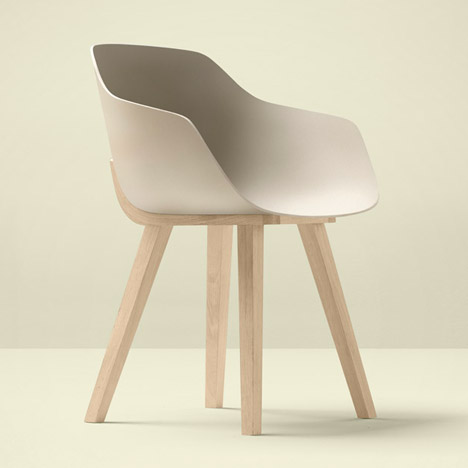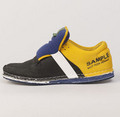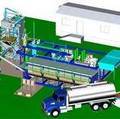Vehicle body made from cotton, hemp, and wood
by: Fraunhofer Research News, 2015-01-05 08:30:00 UTC
Carbon and glass fibers reinforce synthetics so that they can be used for vehicle body construction. But in this regard, there is an abundance of potential found in natural fibers – obtained from hemp, cotton, or wood. If you combined bio-based textile and carbon fibers, you can obtain extremely light yet very sturdy components.
Foraging the Futuristic Recycled Fruits of the Fungi Mutarium
by: design milk, 2015-01-29 19:00:02 UTC

As someone with a deep curiosity for the weird and wonderful world of fungi, the Fungi Mutarium concept by Livin Studio is what I’d call the perfect nexus of mycology, technology, and design coming together in fruition to solve a growing problem: global waste. Designers and researchers are working together and investigating plastic waste as a nutrient source to help grow future foods quite unlike anything available today, all inside a futuristic farming system which wouldn’t look out place within the halls of Salone del Mobile or IMM Cologne.
Fungi has already been explored as an effective non-chemical means of removing toxic substances from both water and soil, and also breaking down synthetic polymers, with myco-technologists like Paul Stamets trumpeting the potential for cleaning the world’s pollution using mycelia’s evolutionary ability to break down long-chain molecules of organic and inorganic matter into digestible form.
The discovery specific fungi are capable of eating up some of the most toxic of materials is spurring on research into fungi as an answer for our global waste problem connected to our addiction to disposable, cheap plastics goods. Fungi may also become the foundation of a new chain of food supply if this intriguing growing system can move beyond the prototype phase and eventually help grace our plates with the “fruits” of its terrarium growing labor.

Designers Katharina Unger and Julia Kaisinger of Livin Studio collaborated with researchers at Utrecht University to devise a system to help precipitate the decomposition of plastic using UV light, then combine the resulting waste matter with fungi and agar to eventually “grow” into an edible pod.

The Fungi Mutarium process:
Plastic is UV treated in the “Activation Cylinder” placed on the bottom of the mutarium. UV light sterilizes the plastic and activates the degradation process of the plastic which makes it easier accessible for the fungi. Plain “FU” (fungus pod) is placed in the mutarium’s Growth Sphere. This is done with pincers to work as sterile as possible. UV-sterilized plastic is put into the “FU”, ready to be digested. “Macerate” (fungi sprouts in liquid nutrient solution) are extracted with a pipette from the Fungi Nursery. Extracted macerate is dropped into the “FU” to ignite the growing process. After a couple of weeks, the ready-grown “FU” can be taken out to be prepared and eaten. 
“We were working with fungi named Schizophyllum Commune and Pleurotus Ostreatus. They are found throughout the world and can be seen on a wide range of timbers and many other plant-based substrates virtually anywhere in Europe, Asia, Africa, the Americas and Australia.Next to the property of digesting toxic waste materials, they are also commonly eaten. As the fungi break down the plastic ingredients and don´t store them, like they do with metals, they are edible.”

Since agar – a common gelatin substitute made from seaweed – is a neutral flavored substance, the harvested mycelium pods (which share a passing resemblance to Cadbury eggs) grown within the Fungi Mutarium are ideal for spicing or pairing with other ingredients in endless combinations. Molecular gastronomists around the world are undoubtedly watching technologies like the Fungi Mutarium, planning for the day when fungi and technology help grow menu ingredients directly from their kitchens while keeping landfills a little less busy.


Goma Wakame Lime FU with Sauteed Cabbage and Caviar served using a special set of Fungi Cutlery designed by Livin Studio. Quite appetizing results considering it’s part plastic bag.

Additional details and videos about the research behind the Fungi Mutarium at Livin Studio.






 Durable Danish seaweed furniture can be reused as fertilizer
Durable Danish seaweed furniture can be reused as fertilizer
by: TreeHugger Design, 2015-01-27 19:15:58 UTC

Surprisingly strong and made with seaweed and a bit of paper, this collection of modern furniture and lighting makes use of an abundant resource.
When These Clothes Wear Out, You Can Throw Them In Your Compost Bin
by: Co.Exist, 2015-01-15 11:00:00 UTC
Three-year-old jeans, meet last week's food scraps. Now it's possible to turn your old clothing into backyard dirt.
Though a lot of clothing is made from natural fibers like cotton, most of it shouldn't be tossed in a compost heap, thanks to things like dyes, buttons, and polyester tags. But Swiss manufacturer Freitag has designed a new line of clothing that's safe for your garden or a city's compost bins.
Read Full Story






 ThisClothing Acts Like A Personal Heater When Temperatures Drop
ThisClothing Acts Like A Personal Heater When Temperatures Drop
by: Co.Exist, 2015-01-16 20:26:00 UTC
Feel the warmth of your own body heat with these new ingenious, nanowire-filled fabrics.
When temperatures drop, you may wear your next heater instead of turning up the thermostat. New nanowire-coated clothing is designed to keep people toasty without wasting energy heating empty spaces in rooms.
Read Full Story






 Chinese Court Clears the Way For Environmentalists to Bring Suit
Chinese Court Clears the Way For Environmentalists to Bring Suit
by: Triple Pundit: People, Planet, Profit, 2015-01-15 10:15:05 UTC
Visions of 2030
by: Triple Pundit: People, Planet, Profit, 2015-01-16 09:45:46 UTC
IKEA Refugee Shelter is a Big Success
by: Jetson Green, 2015-01-15 16:44:37 UTC

In 2013 the furniture giant IKEA, in collaboration with the United Nations Agency for Refugees (UNHCR) developed the so-called Refugee Housing Unit (RHU), a flat packed shelter for housing refugees, which is much easier to assemble and a lot more durable than other such shelters currently in use. Since then, the shelters have been tested in areas like Iraq and Ethiopia and have been deemed a huge success.

The Refugee Housing Unit by IKEA is a shed-like structure, which is made of lightweight polymer panels, laminated with thermal insulation that are clipped onto a steel frame. Each shelter is delivered to the building site in a flat packed package, which is filled with panels, pipes, connectors, wires, etc. just like any other piece of IKEA furniture. Once delivered, it takes about four hours to assemble.

The package also contains a textile sheet with aluminum woven into the material that is meant to cover the roof. This material works to reflect the sun during the day and keep the heat in at night. The shelter also comes with a solar panel that is laminated onto a thin plastic film and provides enough energy to power the built-in lights and a USB outlet.





When erected, the shelter measures 57.5 square feet (17.5 square meters) in height, which is twice as large as the refugee tents currently in use. The units are about 10 feet (3 meters wide) and just under 20 feet long (6 meters long), and feature four windows and one door. Each of the units can house five people. Also, the sturdy walls make it possible to upgrade the structure, such as reinforcing the walls with earth or fitting the structure with a metal roof.
Each unit costs about $1000 to prefabricate in mass production.
 Woodieful: A Chair, Magazine Holder and Side Table in One
Woodieful: A Chair, Magazine Holder and Side Table in One
by: design milk, 2015-01-19 15:00:42 UTC

You gotta love a single piece of furniture with tons of functions and options! The Woodieful Chair is another example of sustainable, multifunctional design. Due to its innovative shape, it can be used in multiple ways, ranging from a stool to even a side table.

Primarily built for sitting, its diminutive shape also allows for it to be easily tucked away when not in use and can hold up to 160lbs. Its various slots provides ample storage spaces for magazines or books when not being used as a stool.

The Woodieful Chair can also be used as a side table or a night stand. Depending on the user, the chair can be set upright or on its side— it is up to the whim of the user.










 Jean Louis Iratzoki designs "first bioplastic chair"
Jean Louis Iratzoki designs "first bioplastic chair"
by: Dezeen, 2015-01-19 13:16:00 UTC

Maison&Objet 2015: Basque designer Jean Louis Iratzoki has moulded the shell of a chair from a plant-based polymer that is fully recyclable and biodegradable (+ slideshow). (more…)



Comments by our Users
Be the first to write a comment for this item.